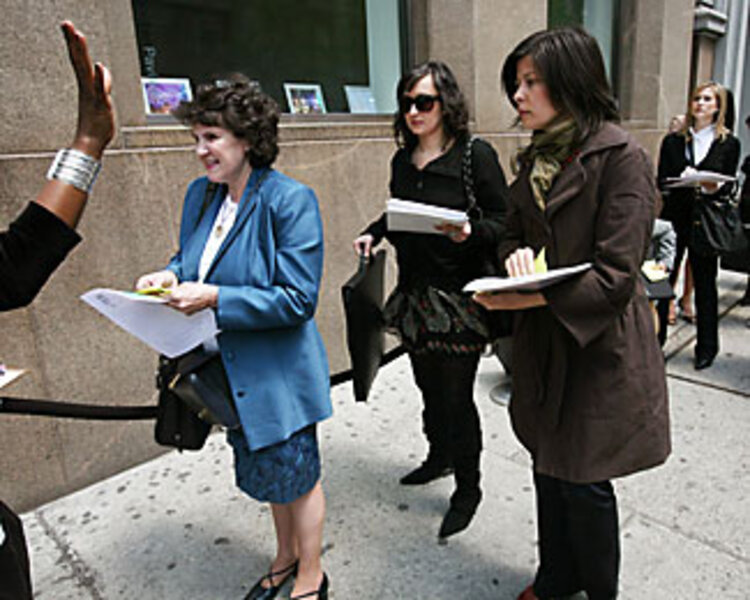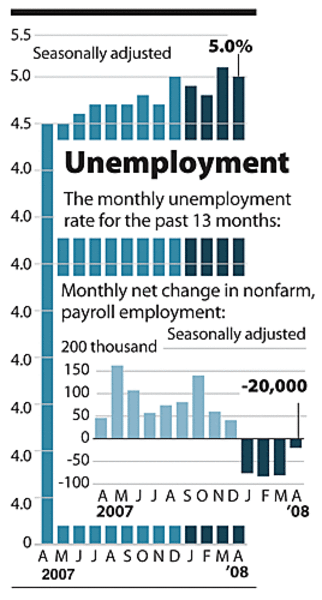Why U.S. job market has not plunged
Loading...
Despite the burdens of record oil prices and a housing bust, the US economy has been avoiding a sharp downturn where it matters most – in jobs.
By the government's initial count, the economy lost hardly any jobs in April, and the unemployment rate actually declined.
What's going on here? Is this the same economy where sky-high costs for gasoline and milk are squeezing consumers, where big banks are in trouble, and where trillions of dollars in housing wealth have vanished?
Yes, it's all the same economy.
Part of the story is that the job market may not be as shock-resistant as it appears. Its general trend is still weakening, and many forecasters expect that to continue in the months ahead.
But another side to the story is that several forces may allow employment to remain relatively resilient in the face of difficult financial straits. That could keep any recession from turning into a severe slump.
"I don't expect this to be a recession of the type that we had in the 1970s," says Peter Rodriguez, an economist at the University of Virginia's Darden School of Business. "Employers have been judicious in making payroll cuts. That's more or less good news."
In the mid-1970s, a deep recession involved both rapid inflation in consumer prices and unemployment of about 9 percent.
Now, the United States again confronts worrisome inflation and a sharp economic slowdown. But some economists predict the jobless rate will rise, by next year, only a bit above 6 percent – about the level where it peaked after the relatively mild recession of 2001.
Economists say the forces at work include:
• Many employers were cautious before the recession. With lean staffs, businesses aren't inclined to jettison employees they worked hard to find and train.
• The US job market is flexible. When times get tight, many people end up working shorter hours or getting smaller raises, but avoiding pink slips in the process. "It does keep people in their jobs," Mr. Rodriguez says.
• Manufacturing is doing better than in most downturns. Factories have cut more jobs than they've added lately, but nothing like the full-scale retreat seen in most recessions. And with exports being helped by a weak dollar, the relative strength of manufacturing could persist.
"We have a manufacturing sector that is faring quite a bit better than it ever has before" in a down economy, says Lakshman Achuthan, managing director of the Economic Cycle Research Institute in New York. Typically, he says, the swing in factory output and jobs accounts for about half of a recession's undertow.
This time around, Mr. Achuthan says, many employers restrained their hiring back in 2006 and 2007, as the fading boom in housing was becoming a focus of business news. Therefore, he says, "there's less cutting to be done."
This may help explain why the economy lost a smaller-than-expected 20,000 jobs in April, according to Labor Department numbers released on Friday.
That was an improvement from the roughly 80,000-per-month pace of job losses in the year's first three months, as tallied in a survey of US employers.
Unemployment, measured in a separate Labor Department survey, fell to 5 percent from 5.1 percent in March.
Still, economists say the job market is weakening, not recovering. Friday's numbers confirmed that on several fronts.
It was the fourth consecutive monthly decline in jobs. Although 20,000 jobs aren't much in an economy of 138 million jobs, the economy needs to add jobs to keep up with a growing labor force.
Wage growth has decelerated and has not kept pace with inflation. April saw a big jump in the number of people who have part-time jobs but want full-time work. The hours in a typical workweek fell slightly. And in April, just 45 percent of industries were adding jobs, down from 55 percent last fall.
Moreover, when the economy is slowing, job numbers are often revised downward in the months after their release.
The question is how well employers will be able to maintain their payrolls. That will depend on consumer spending, hinging heavily on energy and housing. During the boom years for real estate, many borrowed against their rising home equity – and the resulting spending helped fuel the economy. But now home prices are falling at double-digit annual rates.
"It's hard to believe that consumers will continue to spend as readily as they did in the past," Rodriguez says.
Many households will decide to save more of their income, now that home prices aren't doing their saving for them.
Rising gasoline and food costs are also forcing consumers to cut back.
All this doesn't mean consumer spending will be severely curtailed. But these head winds could last a while. Economists at Goldman Sachs forecast that consumer spending will rise just 1.4 percent this year, and 0.6 percent in 2009, versus a 2.9 percent rise last year.
Federal policies may moderately assist.
Taxpayer rebate checks are starting to arrive in the mail, President Bush noted in an address on the economy last week.
"We wanted to make sure that people were encouraged to be consumers," he said. "No better way to stimulate consumption than to let you have some of your own money back." And the Federal Reserve has adjusted monetary policy toward stimulus as well.
The central bank's programs to provide loans on Wall Street, during a period of financial stress, may be bearing fruit. A monthly poll of CEO confidence by Chief Executive magazine posted a rise in April after two months of declines.
"A lot of liquidity has been put into the system," Achuthan says. "It will eventually contribute to a recovery."






